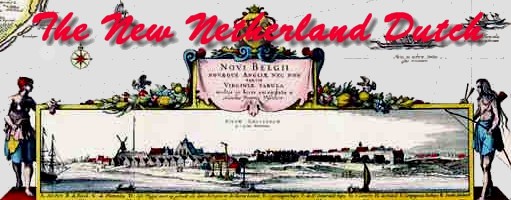
This term of convenience generally is used to describe the Europeans who came to the Dutch West India Company territories in North America between 1624 and 1664. Numbering only a few thousand, they settled primarily in the lowlands that became the states of Delaware, New Jersey, and New York. That regional entity is known today as "New Netherland."
The settlers of New Netherland represented a range of European backgrounds. They had been recruited by the West India Company and by individual company Directors from all the provinces of the Dutch Republic, from the surrounding Low Countries, from Norway, Denmark, and Sweden, from the German states, France, the other countries of continental Europe, and from England, Scotland and Ireland as well. Almost half of those who came to New Netherland before 1664 were technically not of Dutch ancestry. But all of them were transported across the Atlantic in support of Dutch commercial initiatives. They found themselves in a New World that initially was structured by Dutch political and social conventions. Without regard for individual ancestry, these original settlers are widely known today as the New Netherland Dutch.
Most of these émigrés were young and of no particular distinction or attachments in Europe. With a few exceptions, they were extra people whose best option might well have been to undertake a voyage to a new land that was at once mystifying, terrifying, and exciting! Some of these settlers came as families - husbands, wives, and children. Others (chiefly young men and boys) came individually. They were farmers and husbandmen, artisans and tradesmen, soldiers and clerks, laborers, and a few with more specialized training and/or experience as surgeons, ministers, and skippers.
Married settlers raised large families which included children born in Europe and in America. Younger émigrés found marriage partners that often crossed ethnic lines. By 1664, the natural increase of the European-born New Netherland Dutch was largely responsible for the growth of the colony’s settler population to perhaps as many as 9,000 people. The population of New Netherland has been studied and analyzed by David S. Cohen and Oliver A. Rink.
Flourishing demographically, the New Netherland Dutch thus became the core settler stock for most early New York communities in the New York City area, and upriver, particularly in what became Kingston, Schenectady, and most prominently Beverwyck. They also were the primary population source for Rensselaerswyck. By 1664, eighty-two New Netherland family groups were present in the stockaded village that would be renamed Albany. By the time of Albany’s chartering in 1686, their American-born children were raising families whose sons and daughters were marrying and having children of their own. These stories of the original settlers and their descendants have been a primary concern of the Colonial Albany Social History Project. A seminal article addressing the question of "What happened to the New Netherland Dutch?" was published in 1990.
This term does not include Native Peoples who once inhabited the land that became Albany but lived separately from Europeans in the community setting, or African slaves who were brought to America against their will and in most cases could not freely participate in community life.
More than one-tenth of the individuals in the overall People of Colonial Albany community biography were of African ancestry. They were an integral part of the early Albany story and are of special concern in our community-wide inquiry. As research continues, the stories of these Afro Albanians will take their places alongside the Europeans on the community landscape. Before 1664, a small number of slaves were present in Beverwyck. Not calling them original settlers underscores the forced nature of their participation.
The New Netherland Institute hosts A Tour of New Netherland authored by writer/historian Russell Shorto!
Drawing on two essentially exclusive sets of historical resources, Cohen and Rink each presented a paper on the peopling of New Netherland at the Conference on New York State History in 1980. Both scholars showed that the population of New Netherland was made up of émigrés drawn from across Europe and that the actual Dutch were only barely in the majority.
Their articles, David Cohen’s "How Dutch Were the Dutch of New Netherland?", and Oliver Rink’s "The People of New Netherland: Notes on Non-English Immigration to New York in the Seventeenth Century," were published in New York History journal in 1981. Rink’s subsequent book, Holland on the Hudson: The Economic and Social History of Dutch New York (Ithaca and London, 1986), devoted a chapter to "The People of New Netherland." Subsequent scholarship further confirms their findings on the ethnic diversity of New Netherland. Useful emigration information has been presented online by The Olive Tree. See also Janny Venema, Beverwijck: A Dutch Village on the American Frontier, 1652-1664.
Stefan Bielinski, "The New Netherland Dutch: Settling In and Spreading Out in Colonial Albany," in The American Family: Historical Perspectives, Jean E. Hunter and Paul T. Mason, editors (Pittsburgh, 1990). This article places the New Netherland Dutch within a community wide context based on the city census of 1697.
The People of Colonial Albany community biography of 16,000 individual people who lived in the city before the Industrial Revolution includes two half-breed women, Hilletie Van Slyck Van Olinda and Genevieve Masse Lydius, who married Albany traders. As research continues, other Albany people of Native American ancestry still may be identified!
Title design based on a detail from a map of New Netherland dated 1655 and widely reproduced. Numerous versions can be seen online.
The New Netherlands Settlers Project: We are increasingly impressed by and appreciative of this relatively recent [?] initiative. Its thoughtful (and hopefully fluid) consideration of the issues relevant to their/our work both inform and inspire us in our own efforts to define and develop the The people of Colonial Albany Live Here Website. We will be more active users of this resource following our "discovery" of it in 2016.
first posted 1999; development ongoing; last revised 6/20/17